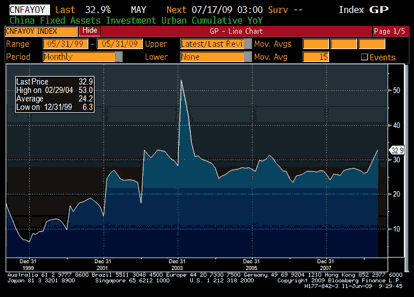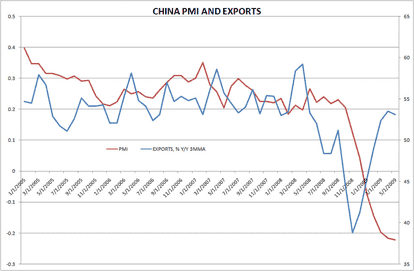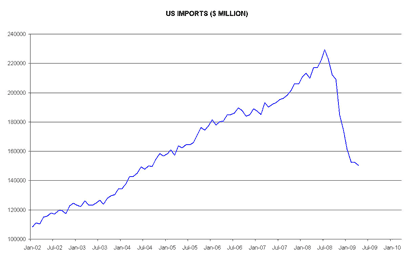Yesterday’s post excited quite a bit of comment from China buffs and commodity hounds alike. The ensuing 24 hours has provided several significant new datapoints with respect to the China story, so in the interest of completeness it’s probably worth addressing them. What can we take away from the investment and trade data?
First, the good news. Fixed-asset investment rose a touch more than expected, climbing 32.9% year-to-date. The green shoots/China growth pimps proponents are pointing to this data as a sure-fire sign that de-coupling lives, China has engineered its own recovery, etc. OK, fine. To be sure, a goodly portion of of this investment has gone into infrastructure projects, particularly in western China. That is pretty valuable.
But capex growth keeps humming along….does the world really need more manufacturing capacity at this juncture? And readers are invited to judge for themselves how sustainable/healthy/desirable it is to see property investment starting to surge again.
The trade data, meanwhile, was less positive. Import and export growth undershot expectations (and by a larger margin, it should be added, than FAI exceeded them) even as Chinese firms continued to increase imports of commodities such as copper and crude.
One of the great things about trade figures in China is that they one of the few datapoints that you can be pretty sure aren’t fudged or manaipulated too badly, since they can be corroborated with similar statistics from China’s trading partners. In that vein, it’s worth noting a remarkable disparity in China’s PMI and its export data. While the PMI accurately herladed the collapse in export growth, to date its rebound has not been matched by a similar renaissance in export data.
While it’s true that the PMI data may now be capturing more fo the iternally-driven investment dynamic within China, it’s worth pointing out that the latest survey had export orders rising.
This, of course, begs the question of who the Chinese plan on selling to. It’s all well and good continuing to build factories and export capacity, but the real world isn’t like Field of Dreams; just because you build it doesn’t mean that customers will come. Yesterday’s US trade figures were telling in that regard. Imports declined again in April; while an inveterate “second derivative” believer may find reasons for optimism in the slight lessening of the pace of import decline in yesterday’s data, Macro Man is rather more sceptical. And the fact that US exports declined as well suggests that domestic demand in the rest of the world remains flaccid at best.
Perhaps May will bring better news for the US consumer (and thus, the Chinese export engine?) We’ll know more in a few hours with the release of May retail sales figures. It will be an interesting test case to see if the reflation story is starting to bite itself in the ass; gas prices rose by 10% in May versus the April average, which should have taken a check out of households’ disposable income.
‘Twill be interesting to see if that fed through into lower demand for non-petroleum products. Macro Man suspects that it probably will have, which will then raise the uncomfortable question of whether we’ve already reached the point of renewed demand destruction in the oil market.
- Bulenox: Get 45% to 91% OFF ... Use Discount Code: UNO
- Risk Our Money Not Yours | Get 50% to 90% OFF ... Use Discount Code: MMBVBKSM
Disclaimer: This page contains affiliate links. If you choose to make a purchase after clicking a link, we may receive a commission at no additional cost to you. Thank you for your support!






Leave a Reply